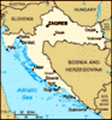Advertisement
Known as the sleepy island, Korcula was founded by the ancient Greeks, then became part of the Roman Empire. Eventually, it became part of the Venetian Republic for four centuries. Korcula is quirky Gothic-Renaissance mixed with a strong siesta tradition. They also insist that the great explorer, Marco Polo was born here in 1254. Who am I to argue with the Venetians? The town is also famous for shipbuilding and the traditional Moreska sword dance. Maybe my buddy Paul will demonstrate that for us at dinner tonight? Bottom line, there is little to do here besides taking it easy. Kick back at a cafe, or lounge on the beach! The main town is also called Korcula (kohr-CHEW lah). Since the town claims Marco Polo, though he sailed under the Venetian Republic, and was technically a Venetian, Korcula claims him to be their own. A festival in his honor, called "the Return to the Age of Marco Polo" is held on the last week of May. Sorry to miss it! But his house is here, though the more recent building site may or may not have been his family's property. From Timeout: Polo certainly fought for the Venetians in the famous Battle
of Korčula in 1298. He was captured by the Genoese and during his imprisonment dictated his famous memoirs to a literate fellow inmate. Indeed, DePolo has for centuries been a common family name here. The house frequently shown to tourists as Marco Polo’s birthplace is actually a 17th-century structure said to be built on the site of his former home – that shouldn’t take the romance out of what remains a plausible story. The Hapsburgs also took control here in the late 19
th century. I wish I could tell you more, but this is "all there is."
It is the sixth largest island in the Croatian Adriatic. And it has vineyards and olive groves, so it can't be all bad. St. Mark's Cathedral is one of the finest examples of Dalmatian church architecture and design.
More from Timeout: The island’s main town of
Korčula contains the
Lešić Dimitri Palace, one of the few genuinely boutique hotels on the Adriatic, and also a boutique sweetshop in the shape of the famed Cukarin. In addition, the island can claim to offer a boutique white wine in the shape of Grk from the village of
Lumbarda, a boutique local pasta in the form of Žrnovski makaruni, and boutique olive oils from the family-run presses around
Vela Luka. The dramatic sloping rocks of Proizd island, just off
Vela Luka, provide Korčula with a likely contender for the title of Dalmatia’s foremost boutique beach.
Here is an interesting wine story for Korcula:
When phylloxera (vine lice) reached the island in 1925, centuries-old vineyards were abandoned and thousands of Korčulans emigrated to North America or Australia. Olive plantations to some extent replaced the vines, although the tendency of the remaining islanders to take up jobs in shipbuilding or (somewhat later) in tourism condemned many of Korčula’s agricultural terraces to a long period of neglect.
‘Everything to the left and right of here used to be vineyards’ says winemaker
Frano Milina-Bire, pointing to scrub-covered slopes overlooking the sea on Korčula’s south coast. Running down the middle of the overgrown hillside is a strip of new terraces planted by Bire himself last year; a geometrical grid of metal sticks, each with a slender young vine strapped to the base.
Bire is a keen advocate of the revitalisation of old vine terraces south of the seaside village of Lumbarda. It is the heartland of Grk, a refreshing white wine made from grapes that only grow in this part of Korčula. ‘It is important to preserve Grk and encourage ecological production at the same time’ says Bire. ‘There are a lot more old terraces around the place and the potential for further revitalization is enormous.’
The back-breaking hard work that created the Korčulan landscape has an almost spiritual significance for Korčula’s new breed of wine and olive growers, as if their diligently crafted produce represents tangible tribute to the agricultural toil of the past. ‘Grk is one of the oldest grapes on the Adriatic’ Bire explains. ‘The Ancient Greeks who settled here were growing it well over 2000 years ago.’ Grk is so localised (attempts to grow it elsewhere have never met with much success) that annual production rarely exceeds 25,000 bottles, little of which gets off the island.
Advertisement
Tot: 0.084s; Tpl: 0.011s; cc: 14; qc: 29; dbt: 0.038s; 1; m:domysql w:travelblog (10.17.0.13); sld: 1;
; mem: 1.1mb







